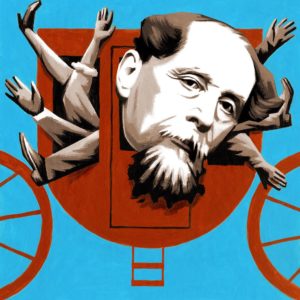
ILLUSTRATION: THOMAS FUCHS
Today’s jet passengers may think they have it bad, but delay and discomfort have been a part of journeys since the Mayflower
The Wall Street Journal, September 20, 2018
Fifty years ago, on September 30, 1968, the world’s first 747 Jumbo Jet rolled out of Boeing’s Everett plant in Seattle, Washington. It was hailed as the future of commercial air travel, complete with fine dining, live piano music and glamorous stewardesses. And perhaps we might still be living in that future, were it not for the 1978 Airline Deregulation Act signed into law by President Jimmy Carter.
Deregulation was meant to increase the competitiveness of the airlines, while giving passengers more choice about the prices they paid. It succeeded in greatly expanding the accessibility of air travel, but at the price of making it a far less luxurious experience. Today, flying is a matter of “calculated misery,” as Columbia Law School professor Tim Wu put it in a 2014 article in the New Yorker. Airlines deliberately make travel unpleasant in order to force economy passengers to pay extra for things that were once considered standard, like food and blankets.
So it has always been with mass travel, since its beginnings in the 17th century: a test of how much discomfort and delay passengers are willing to endure. For the English Puritans who sailed to America on the Mayflower in 1620, light and ventilation were practically non-existent, the food was terrible and the sanitation primitive. All 102 passengers were crammed into a tiny living area just 80 feet long and 20 feet wide. To cap it all, the Mayflower took 66 days to arrive instead of the usual 47 for a trans-Atlantic crossing and was 600 miles off course from its intended destination of Virginia.
The introduction of the commercial stage coach in 1610, by a Scottish entrepreneur who offered trips between Edinburgh and Leith, made it easier for the middle classes to travel by land. But it was still an expensive and unpleasant experience. Before the invention of macadam roads—which rely on layers of crushed stone to create a flat and durable surface—in Britain in the 1820s, passengers sat cheek by jowl on springless benches, in a coach that trundled along at around five miles per hour.
The new paving technology improved the travel times but not necessarily the overall experience. Charles Dickens had already found fame with his comic stories of coach travel in “The Pickwick Papers” when he and Mrs. Dickens traveled on an American stage coach in Ohio in 1842. They paid to have the coach to themselves, but the journey was still rough: “At one time we were all flung together in a heap at the bottom of the coach.” Dickens chose to go by rail for the next leg of the trip, which wasn’t much better: “There is a great deal of jolting, a great deal of noise, a great deal of wall, not much window.”
Despite its primitive beginnings, 19th-century rail travel evolved to offer something revolutionary to its paying customers: quality service at an affordable price. In 1868, the American inventor George Pullman introduced his new designs for sleeping and dining cars. For a modest extra fee, the distinctive green Pullman cars provided travelers with hotel-like accommodation, forcing rail companies to raise their standards on all sleeper trains.
By contrast, the transatlantic steamship operators pampered their first-class passengers and abused the rest. In 1879, a reporter at the British Pall Mall Gazette sailed Cunard’s New York to Liverpool route in steerage in order to “test [the] truth by actual experience.” He was appalled to find that passengers were treated worse than cattle. No food was provided, “despite the fact that the passage is paid for.” The journalist noted that two steerage passengers “took one look at the place” and paid for an upgrade. I think we all know how they felt.





